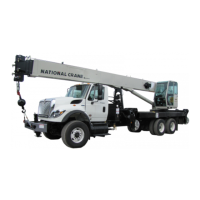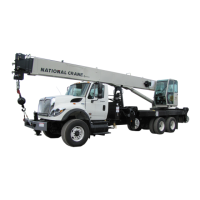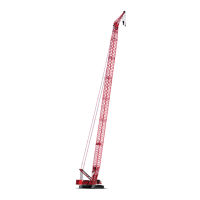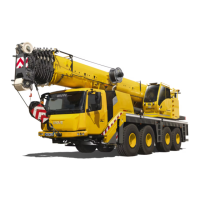Manitowoc Published 03-29-17, Control # 064-23 v2 4-107
14000 OPERATOR MANUAL SETUP AND INSTALLATION
LOAD LINE REEVING
Wire Rope Specifications
See Wire Rope Specifications Chart in Capacity Chart
Manual for the following information:
• Parts of line required for various loads
• Wire rope lengths and notes about hoisting distance for
various parts of line
• Maximum spooling capacity of load drums
Wire Rope Installation
See Wire Rope Installation on Page 98 for the following
instructions:
• Anchoring wire rope to drums
• Installing wire rope on drums
• Anchoring wire rope to socket and wedge
Liftcrane
Reeving Diagrams
See Figure 4-57 for suggested reeving diagrams.
See Figure 4-55
for component identification and dead-end
locations in boom and jib.
Dead-End Locations – Lower Boom Point
Depending on reeving requirements, it may be necessary to
switch the middle and right sheave clusters (as viewed from
rear) to properly position the dead-end link. See Lower Boom
Point Assembly on Page 89
for instructions.
Guide Sheave Identification
See Figure 4-56 for identification of wire rope guide sheaves
in the boom and the jib strut.
The guide sheaves must be positioned at the specified
dimensions to ensure proper fleet angles.
Load Blocks
Refer to the Boom and Jib Assembly Drawings at the end of
this section for load blocks and weight balls available from
Manitowoc:
CAUTION
Wire Rope Damage!
Avoid wire rope damage from improper fleet angle or
contact with adjacent parts. Do not hoist load block or
hook and weight ball any closer to boom or jib points than
specified in reeving diagrams (Figure 4-57
).
WARNING
Falling Load Hazard!
Avoid damage to wire rope or wire rope guides. Route
wire rope from load drums through proper sheaves in wire
rope guides as shown in Figure 4-55
and Figure 4-56.
Failing to route wire rope as shown can cause wire rope to
break and load to fall.
WARNING
Falling Load Hazard!
Load block capacity must be equal to or greater than
weight of load to be handled. Load block can fail if
overloaded, allowing load to fall.
WARNING
Avoid Death or Serious Injury!
Exercise care when block is standing in vertical position,
as the potential for tipping exists. Potential causes of
tipping are unstable work area, boom movement and the
reeving process.
If work area is unstable, lay block flat on side plate.

